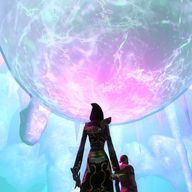Legend
Knowledge of Mythallar is not a common thing, but in retelling of ancient powers there are other words describing these sources of immense power. The objects appeared as great glowing orbs of magical energy used to create otherwise godlike effects on the weave of the world. Perhaps the most famous / notorious being the flying cities ("enclaves") of The Netheril.
Scholarly History
(Very few in present Faerûn would know this version - Alyks Askaria happens to be one who knows much of this, following her years as a librarian at the Host Tower of the Arcane Brotherhood, with any gaps filled in by Mormesk).
Creation of the first mythallar is credited to the Netherese wizard Ioulaum around -3000 DR, followed later by the first enclave, Xinlenal. Ioulaum's mythallar-extended life allowed him to train thousands of arcanists, spreading the arts and giving rise to greater and greater powers for the Netheril Empire. In his crafting of the first mythallar, Ioulaum built upon the principles of the magical items called Ioun Stones, developed centuries earlier by the genius arcanist inventor Congenio Ioun, said to be in secret a student of one of the most ancient powers - the Terraseer Arthindol.
Mythallar had the appearance of crystal balls - some 150 feet in diameter, and so bright looking directly into them could blind as looking into the sun. Shielded, one would see shadows and shapes of fluorescent colors moving across the surface. Their powers had a range limit, so larger cities and enclaves might require multiple mythallar. Some are said to have had a dozen. Touching mythallar is said to destroy any living, undead, or item except for the very special structures created to hold them in place.
In addition to allowing cities to fly, it is said the mythallar were used to power alterations to the weave ranging from weather control to refrigeration to shield walls to imposed obedience to magical suppression to mining to agriculture to food-gathering to fire suppression to longevity to (essentially modern electricity for appliances, light, motors, etc. - allowing enchantments to persist without recasting or permanency spells). Of course, if a mythallar was destroyed or malfunctioned - these effects would end (particularly nasty if city-levitating or wizard life-extending!) One of the mythallar is said to have awakened and become sentient.
Mythallar reached deep into the weave of Mystryl, the goddess of magic - now remade as Mystra. In addition to complex and many-layered ritual magics in their creation, mythallar required an enormous quantity of rare material components including precious metals (copper, silver, gold, platinum, mithril, and adamant), gemstones, and (most crucially) the magic-binding mineral Chardalyn. It is likely the lore intentionally omits components that may be taken as controversial - if not scandalous - such as sacrifice of living things with affinities for magic (some suspect unicorns).
(See also: wiki)
